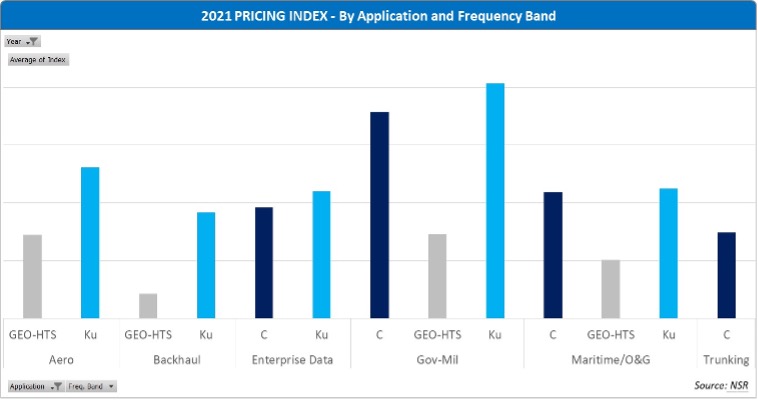|
Shifting Sands Of Satcom
Capacity Pricing
April 28, 2021 by Carlos Placido |
NSR
Historians point out that a common
effect of pandemics is the acceleration of trends
already underway. This concept may well apply to
high-profile satcom players filing for Chapter-11 during
2020, all within a relatively short period of time; a
scenario previously foreseen but precipitated by the
pandemic. The emergence of LEO mega-constellations also
exhibited accelerated progression during 2020, with
SpaceX reaching a remarkable cadence in satellite
manufacturing and launch, to name only a few SpaceX
achievements. The looming completion of Starlink’s first
sub-constellation with 1,584 satellites points to
structural changes in the years to come as other Non-GEO
and VHTS players enter the race, pressing for
“multi-orbit” competition in data markets.
Interestingly enough, as far as
satellite capacity pricing is concerned, several markets
are approaching price stabilization across regions, if
only temporarily. Mobility applications (namely maritime
and aero) that were the “star” performers driving
pre-pandemic revenue growth for operators became the
ones most adversely impacted by the pandemic from a
demand standpoint. Supply-demand dynamics always
influence capacity pricing, but under the conditions of
a COVID-19-inflicted demand drop, expected to be
temporary, it is also worth looking into other just as
important factors affecting pricing for each
application.

Q1 2021 Global Pricing Index.
Source: NSR’s SCPI7 Pricing Index Dashboard for Q1 2021.
Global Pricing Index expressed in $/MHz/Month for
widebeam C and Ku band capacity and in $/Mbps/Month for
Ka/Ku HTS. Global Index averages all regional indexes
disregarding differences in regional bandwidth uses.
In NSR’s Satellite Capacity Pricing
Index, 7th Edition (2021) report (SCPI7); NSR digs into
many aspects driving pricing dynamics for the main
FSS-band applications and across all regions. NSR
developed a “Pricing Index Dashboard” to combine and
visualize pricing data based on user selectable filters,
including regions, frequency bands and applications.
Using the dashboard to benchmark and compare the global
pricing index for B2B data applications (this article
ignores consumer broadband and video/DTH markets, which
are included in the report), we can visualize the
effects of application-specific trends:
Aero: Wide regional differences
exist in this segment, where leading regional airlines
are at different stages in the IFC diffusion curve and
supply-demand affects pricing. Prior to COVID-19, Ku
band demand was generally perceived ahead of supply in
key battleground regions. During 2021, prices have
stabilized or even slightly increased despite COVID-19.
Aero will be a key target market
for Non-GEO constellations, so current price
stabilization led by integrated Ku- and Ka-band IFC GEO
ecosystems may give way to increasing levels of
competition and price pressure.
Backhaul: Wireless Backhaul is a
wholesale ‘volume’ market and, as such, drives high
discount levels in negotiations. FSS and HTS exhibit
similar declines on a % basis, but MNOs are increasingly
interested in the advantages of HTS, not only in terms
of costs but also in terms of the ability for VSATs to
grow return link throughput as demand evolves. The
pandemic has, as a matter of fact, made LTE backhaul
traffic more symmetric, so HTS architectures could run
with return-link scalability “plus” in negotiations.
.png)
Enterprise VSAT: Continued pressure
on FSS pricing remains from HTS. Enterprise VSAT
networks continue to leverage the wide area statistical
advantages of widebeam coverage, but HTS offerings “pin”
customer price expectations, driving the homogenization
of widebeam and HTS per-bit pricing in some regions.
Gov-Mil: Continuous correction seen
in the market towards the highest range of Gov-Mil
pricing, though this vertical remains the highest
priced. Pricing decline slowed in 2021, but pressures
will intensify once constellations complete coverage,
and VHTS satellites are launched.
Maritime /O&G: While price has
generally stabilized, the pandemic seriously impacted
the bandwidth-hungry cruise sector resulting in
large-volume contract renegotiations and revenue losses
for end users, service providers and operators. O&G also
had a bumpy year, but oil prices returning to reasonable
levels point to business recovery.
While not expressed by every LEO
constellations player, it is undeniable that most, if
not all, will aggressively target energy and maritime
segments to increase global fill rates, giving way to
renewed price pressure during or after 2022.
Trunking: Declines in C-band
trunking price continue on account of C-band repurposing
across a few regions and limited alternate uses outside
video distribution. Price erosion, combined with high
data-rate C-band trunks -which generally use advanced
coding and network optimization technologies- continue
to push the boundaries of satcom spectral efficiency.
Spectral efficiency and capacity
portability are two important aspects at play when
benchmarking pricing per application. HTS price in SCPI7
is provided in $/Mbps so applications driving high
spectral efficiency can achieve lower price points by
virtue of better use of satellite spectral power and
spectrum. This can be clearly seen by comparing backhaul
pricing versus aero.
Mobility lease contracts often
include portability clauses, allowing large users to
shift capacity requirements across satellites and beams.
Contract re-negotiations affected portability, thus
stabilizing or even increasing unit pricing despite
certain oversupply conditions.
Bottom Line
Each major satcom application is
exhibiting distinct pricing dynamics with long-term
fundamentals for the satellite industry at large
remaining positive, albeit with long-term structural
shifts driven by looming VHTS and LEO/MEO constellations
programs.
The satellite industry is
–obviously– not immune to the effects of the pandemic.
Less obvious to “black swan” events like COVID-19 are
that unpredictable and often counter-intuitive
consequences. Price stabilization and increases can
indeed occur so, while supply-demand dynamics apply,
pricing is also modulated in new ways, beyond the realm
of normal-market expectations.

Fullerton (formerly
Westin) Hotel, Sydney
New Dates - 22 & 23 June 2021
Contact: kfrench(@)talksatellite.com
|